Libya is one of those countries where the government changed so recently, you still see the old flag of Libya quite a bit. Do a Google image search, you’re likely gonna see as many of one flag as the other. So it’s pretty normal for someone casually to wonder “What’s the flag of Libya again?” And if you’re someone who’s really into flags, maybe you wanna know why it changed in the first place. What does the new one mean, and for that matter, what did the old one even mean? Well we here at YPT are going to answer all your burning questions about the history of the Libyan flag!
The Current Flag of Libya
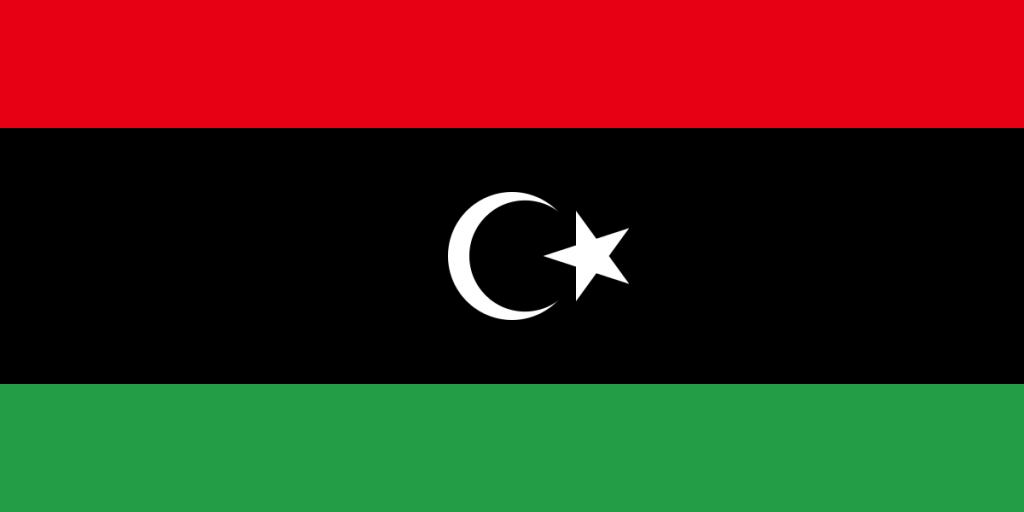
Okay, so I lied a bit. Just a little lie. This isn’t really the ‘new’ flag so to speak. It actually pre-dates the old flag, going back to the creation of the Kingdom of Libya in 1951. Minister of Defence Omar Faiek Shennib is said to have made the original design, basing it off of a ‘Senussi’ dynasty banner. The Senussi dynasty controlled the east of modern-day Libya for many years, their banner featuring the black background with white crescent, while the addition of green and red was new. It makes sense that this’d be the flags origins, since the new Libyan king Idris was the leader of the Senussi Order, a Sufi Islamic brotherhood drawn from the old dynasty.
Besides the purely historical reasons for the flag of Libya, there’s a lot of symbolic meaning too. The crescent moon is a traditional Islamic symbol seen in many other flags to this very day. It represents the beginning of the lunar month, while the star variously means the hopes and aspirations of the Libyan people, as well as their faith in Allah. This is drawn from an Islamic brotherhood after all. The black background meanwhile is inspired by the black flag carried by the prophet Muhammad. Lastly, red supposedly refers to the blood of Libyans who died fighting Italy, while the green represents the land along the coast.
One last reason for the colours, as there should always be several reasons, is that the three historical territories of Libya used those colours for their corresponding flags. The Senussi dynasty controlled Cyrenaica, represented by black. Tripolitania (based from Tripoli and covering the north-western coast of Libya) gets the green and Fezzan gets the red, which was the more arid region south of Tripolitania and west of Cyrenaica. Altogether, I’d say that’s a lot of good reasons for the flag of Libya! But it certainly wasn’t the only flag… We’ll get to that big green beauty soon, but let’s see what came right after this one was discontinued.
Flag of the Libyan Arab Republic – (1969-1972)
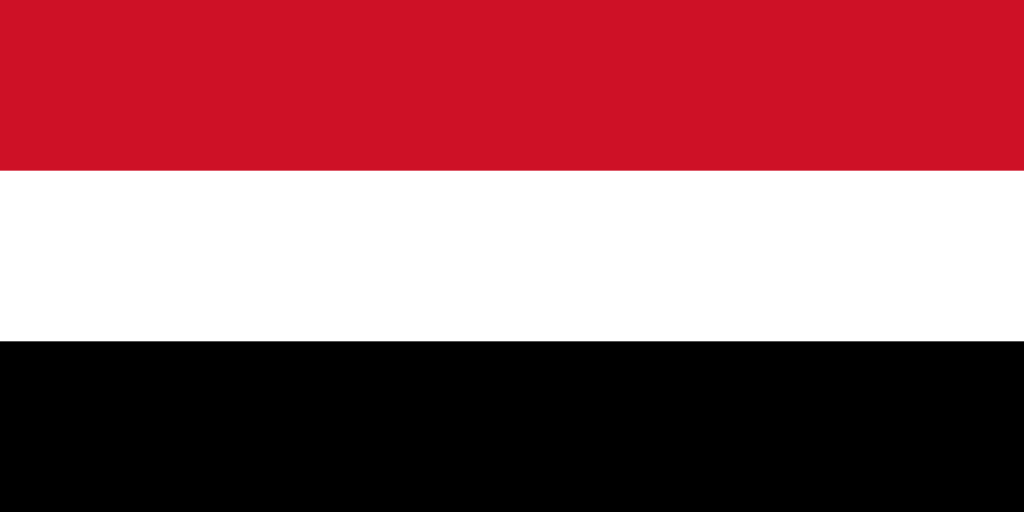
The kingdom didn’t work out too well in the end. Like a lot of the formerly colonized world, its first post-colonial government had a lot of meddling. Now king Idris had a lot of genuine support, but his political position was still weak enough by 1969 that the whole country fell to an (almost) bloodless military coup while he was out of the country. The head of this coup: Colonel Muammar Gaddafi, an idealist wanting to follow in the footsteps of Nasser and build pan-Arab unity. This is pretty critical to understanding the flag you see before you. A flag that may strike you as a little… Familiar looking, if you’ve looked at flags over in the middle-east.
The flag of Libya at this time wasn’t really a flag for Libya at all. It was the Arab Liberation Flag, as used in the Egyptian revolution of 1952. Once again, it goes back to Nasser. This flag itself takes influence from early pan-Arab flags, most notably the ‘flag of Arab revolt’ which consists of a pointed red arrow covering the left of a black, green and white tricolour. The intentions of these colours was to evoke historical banners of Islamic caliphates. Black for the standard of Muhammad, white for the Umayyad’s, green for the Fatimid’s and red for Hashemite’s.
As for why the green is left off the Arab Liberation Flag… Perhaps because the Fatimid caliphate were Shia, as opposed to the heavy Sunni influence in Egypt. Or perhaps because it had little overlap with the historical Egyptian state. In any case, this flag soon spread to many pan-Arab minded revolutionary governments. Egypt maintains it with a crest, Iraq has had it before, during and after Saddam in various ways, Syria still has it, Sudan seems notably inspired and hell, the Yemeni flag is the exact same as this old flag of Libya! The intention clearly was not to stake out a firm national identity with the flag of Libya, but rather to prepare for a unified Arab state.
Flag of the Federation of Arab Republics
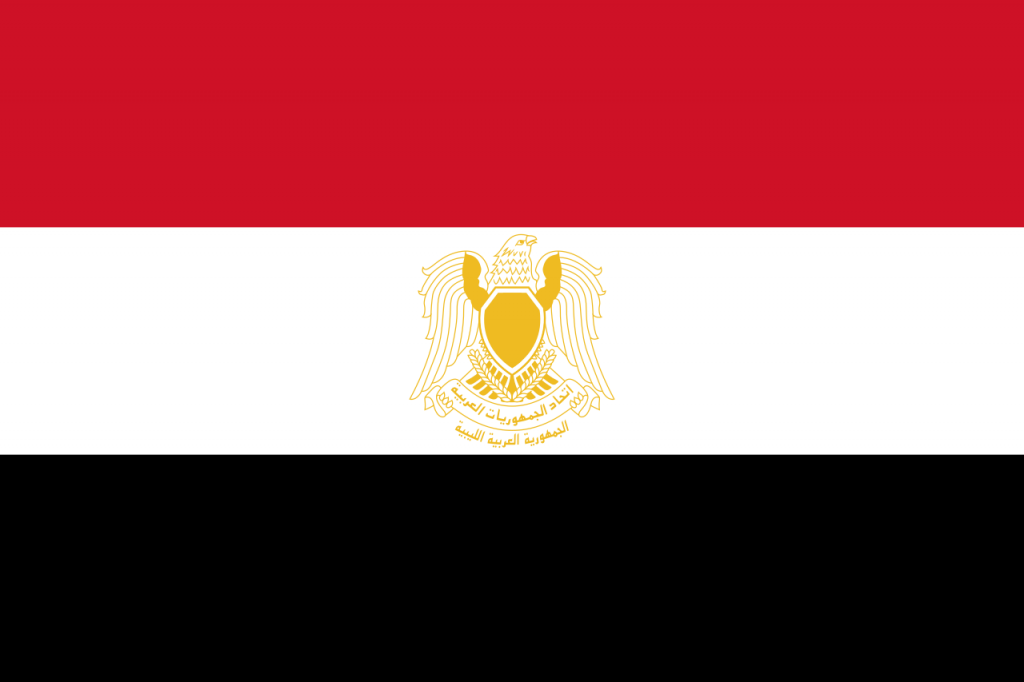
By 1972, Gaddafi wanted to put his pan-Arab beliefs into practice. He had the right allies who agreed with him and at last, the flag of Libya changed once again as the countries of Egypt and Syria united to kick off a pan-Arab era… And it didn’t accomplish very much. Within a year, relations began to deteriorate over Egypt’s recognition of Israel and normalisation of relations with America which left an agreement on closer outright unification left on the table. The political union meant more on paper than in practice, but for a good few years, these countries shared a flag.
The background is of course obvious, but what’s the deal with the eagle? Or rather, the hawk. The Hawk of Quraish is another popular pan-Arab symbol that’s been used by a good few countries in the Arab League and has its direct roots in the second Syrian republic of 1950-1963. Falconry, or I guess hawkery in this case, is a traditionally popular pastime in a lot of the Arab world, with some claims that it was a symbol used by tribes under the command of the prophet Muhammad.
Imagery from the alliance remained in use in Syria and Egypt well into the 80s, but Libya completely withdrew in 1977. There were already outright covert attacks allegedly committed by Libya against Egypt in 1976, but on March 2nd, 1977, Gaddafi unveiled a new government and a new flag of Libya. This was the…
Flag of the Great Socialist People’s Libyan Arab Jamahiriya

Just rolls right off the tongue, don’t it? To be fair, it wasn’t called that to begin with. The ‘Great’ didn’t get added on until 1986. But first off, what the hell’s a Jamahiriya? Broadly speaking, it means ‘state of the masses’ and has even been translated as being an Arab equivalent of a people’s republic, reflecting Gaddafi’s increasing embrace of a certain strange spin on socialism that you can bet I’ll be discussing in more detail some other time. The old Hawk of Quraish continued as an emblem, now with its shield a deep green. Which is the next notable thing to talk about. The green-ness of the flag of Libya.
So yeah, an altogether very green looking flag of Libya. In fact, it’s the only modern national flag to be one solid, basic colour. Gaddafi had a bit of a fixation on the colour green, ironic considering its omission from the traditional pan-Arab flag he’d adopted in 1969. His political ideology, third universal theory, was outlined in his manifesto ‘The Green Book‘. No, not like the movie. The colour can be tied to a few things besides the Fatimid caliphate. Green is in fact a colour broadly associated with the Muslim faith, while more directly, green was a prominent colour for the old state of Tripolitania Which we’ll get to.
Gaddafi tried to use green the way communists use red. He whipped up his own cultural revolution and made the colour of the flag prominent in all aspects of life. He himself often wore green clothing and Gaddafi loyalists to this very day hoist high the green flag of the Jamahiriya. And this is how it stayed, through the 80s, 90s and 00s, right up until the flag of Libya changed back once again in 2011, resetting to before Gaddafi’s takeover. So that’s it. I think we’re done here. If you’d like to know more, check out this article all about Libya under Gaddafi.
Other Flags of Libya
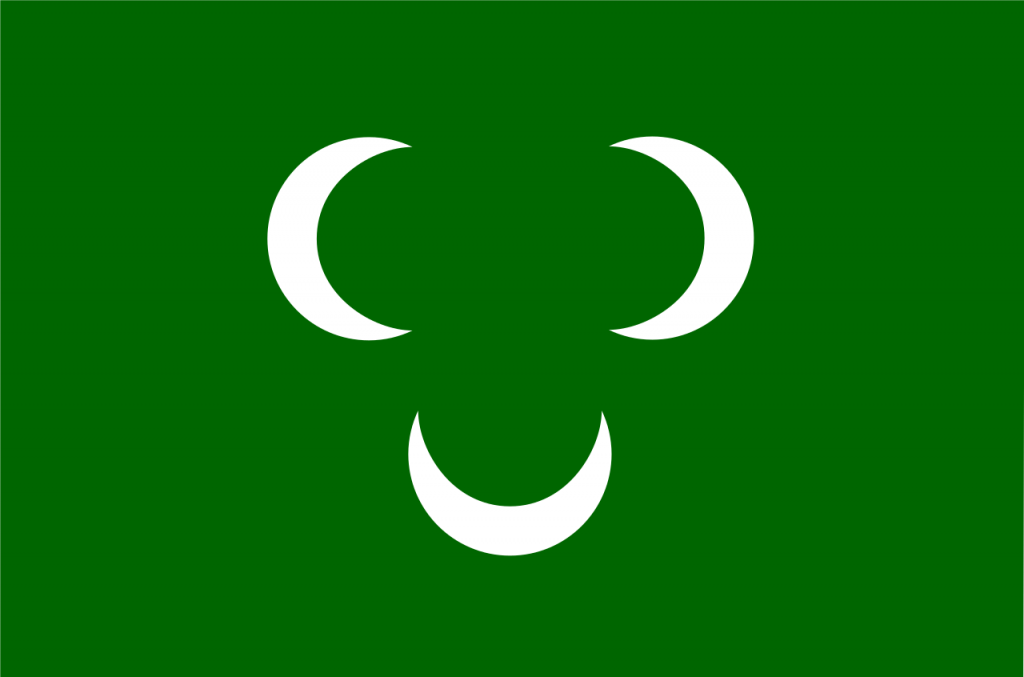
Now that we’ve discussed the more modern flags of Libya, let’s look at the others. The older ones and the not-so-official ones. Starting with this beauty above, where you can certainly see where Gaddafi got his whole ‘green’ thing from. This is the flag of the ‘Kingdom of Tripoli’, a not-quite kingdom that was more a semi-autonomous province of the Ottoman Empire, allowed to hang onto its royal family. It lasted from 1864 to 1911, when it was captured by the Kingdom of Italy and had its beautiful independent flag replaced with the boring Italian flag of the era. The flag was fairly simple, a green field echoing the Fatimid caliphate with three crescent moons, prominent Islamic symbols.
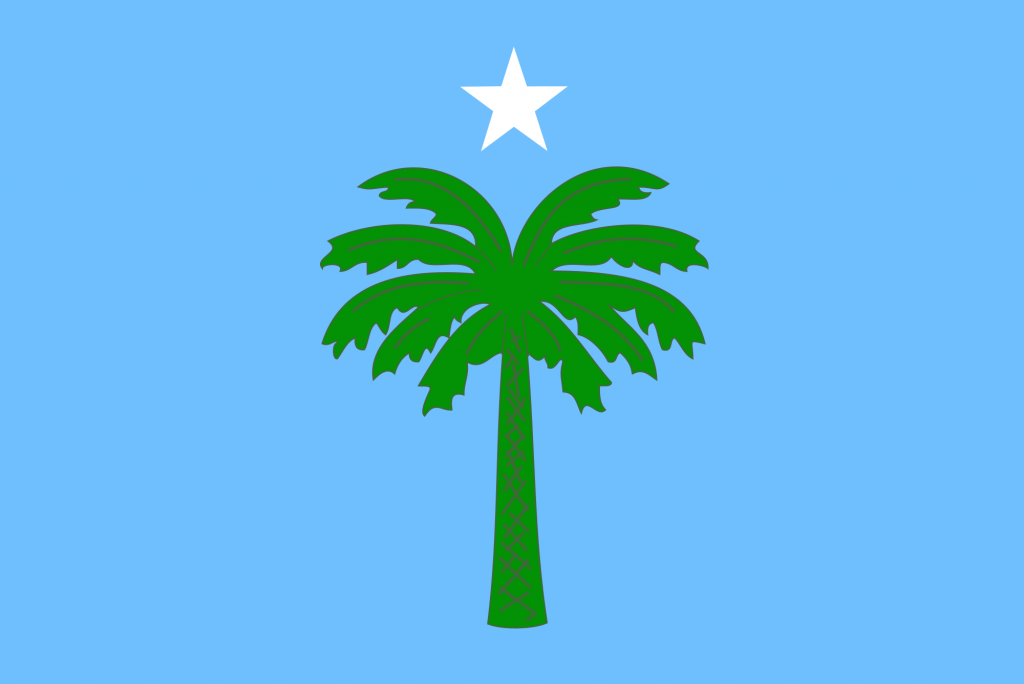
This second flag of Libya is from 1918, following the collapse of the Ottomans. The Kingdom of Italy was to retain control of all Libya, but some wished to resist! Those in Tripolitania broke away to form the Tripolitanian Republic, the first modern Libyan republic. The flag of Libya at this time looks similar to the modern Somalian flag, with a blue background and a white five-pointed star, though at the top rather than the middle. Most striking is the big green palm tree, coloured solidly rather than reflecting a real palm tree. Another reference to the Fatimids? While also referencing the Libyan coast, with its blue seas, green trees and starry skies. Also the Islamic connotations of the star.
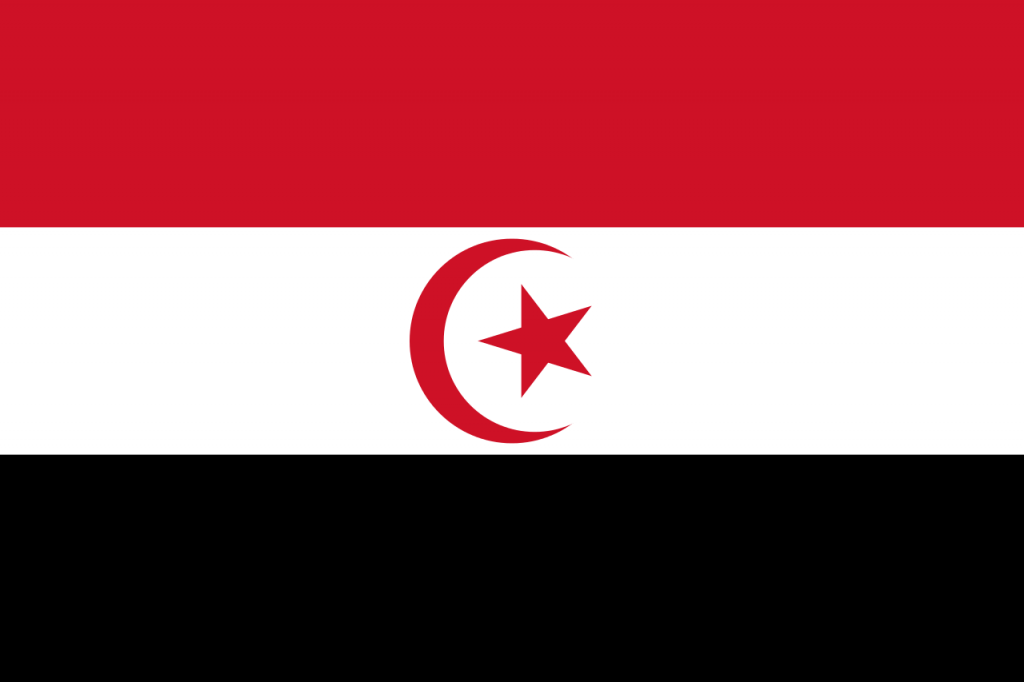
Skipping past the post-WW2 flags of Britain and France that administered large chunks of Libya for a few years, we have a failed experiment happening at the same time as the Federation of Arab Republics, in 1974. This was the Arab Islamic Republic. Yet another Gaddafi-sponsored merger, this time of Libya and Tunisia with interest from Algeria in joining. This flag is a merger of the then-Libyan flag with the Tunisian flag, taking its red moon and star which evokes the Ottoman Empire. The union did actually happen! But collapsed in a few days. The disagreements were many and some argue Algeria and Tunisia only initiated the idea to break Libya away from Egypt, which happened on its own.
One Last Flag of Libya!
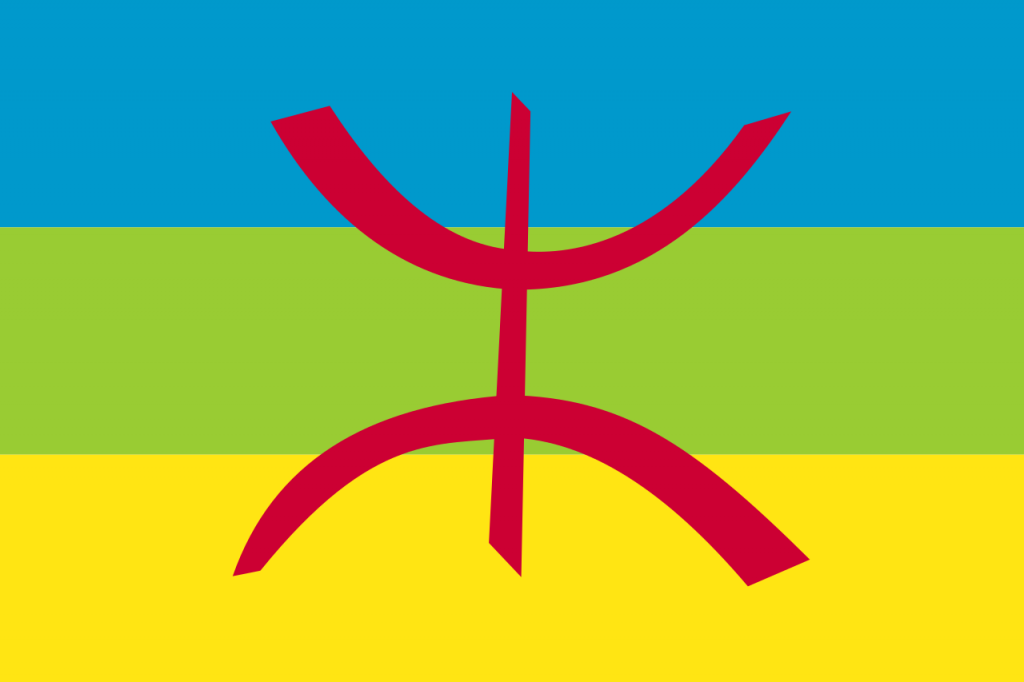
Look at this beauty. What we’re looking at here isn’t a Libyan flag as-such, but it’s most certainly a flag of Libya. This is the flag of the Berber/Amazigh people. The Berbers are a north-African ethnic group numbering between 50-70 million people, 3.8 million of which live in modern Libya, a country with a total population of just under 7 million. Now, many of these are Arab-Berbers and so full ethnic Berbers remain a minority in Libya, but they are certainly substantial. They’ve lived there since long before there was a Libya and they aren’t going anywhere. Even Gaddafi was part Berber! …And this didn’t help too much.
Gaddafi persecuted the Berbers heavily. Their language and culture were effectively banned and the people were forcibly ‘Arabized’, with even Berber names being outlawed. Naturally, this beautiful flag of Libya was also banned by Gaddafi’s government and people could be arrested and possibly killed for displaying it. To this day, Berbers still face indifference at best and hostility at worst from parts of the Libyan government, but now they can at least fly their flag proudly. And yes… Let’s get back to the flag.
The flag was created by the World Amazigh Congress in 1998, its colours representing the ‘Tamazgha’ region of Africa where Berbers predominantly live. Blue represents the sea to the north, green represents the more lush coast and mountain ranges while the yellow represents the desert further south. The red symbol is a letter in the Berber alphabet, Tifinagh, which represents the freedom of the Berber people. Now again, I don’t know if this really counts as a ‘Libyan flag’, since it certainly doesn’t represent Libya as a nation. But it definitely deserves to be recognized as a flag of Libya.





